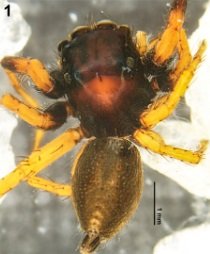In a remarkable discovery highlighting the rich biodiversity of Tamil Nadu, a new species of jumping spider, Carrhotus piperus, has been identified in the lower Palani Hills. This discovery brings the total number of Carrhotus species found in India to 10, with 37 known worldwide. The findings shed light on the region’s unique ecosystems and underscore the importance of continued research in India’s lesser-explored habitats.
Discovery Details
The spider was discovered in 2016 during a biodiversity survey in Thadiyankudisai, Dindigul district, nestled in the Palani Hills. A team of researchers led by John Caleb T.D. from Saveetha Institute of Medical and Technical Sciences and M. Sampathkumar from the ICAR-National Bureau of Agricultural Insect Resources played a key role in identifying and scientifically describing the new species. Their discovery has been published in the Journal of Insect Biodiversity and Systematics.
The name Carrhotus piperus was chosen to reflect the spider’s unique habitat—Piper nigrum, commonly known as the black pepper plant, where it was found living about two meters above ground. This species exhibits a close relationship with the plant, from which it draws its name, indicating a symbiotic connection between the spider and its environment.
Habitat and Physical Features
The discovery of Carrhotus piperus among black pepper plants adds a new dimension to the understanding of the ecological balance within the Palani Hills. The spider was observed residing on the plants, which are cultivated for their spices, suggesting that the spider might play a role in maintaining the health of these plants or the ecosystem around them.
The newly discovered spider stands out due to its distinct physical features. It has a prolateral protrusion—a unique bump on its body—and a beak-shaped embolus, part of its reproductive anatomy. These characteristics helped scientists classify it as part of the Carrhotus genus, a group of spiders known for their ability to leap and hunt without the use of webs.
Importance of the Discovery
This discovery expands the knowledge of the Carrhotus genus and provides further insight into the biodiversity of Tamil Nadu’s Palani Hills. The findings highlight the need for ongoing research into India’s rich ecosystems, particularly in under-explored areas like the Palani Hills, which serve as habitats for a range of undiscovered species.
John Caleb T.D. and M. Sampathkumar emphasize the importance of biodiversity conservation, stressing that new species discoveries contribute to a greater understanding of ecological health and the relationships between organisms and their habitats.
Facts About Jumping Spiders
Jumping spiders, belonging to the family Salticidae, are among the most fascinating members of the spider world:
- Superior Vision: They have excellent vision and are capable of seeing in color, making them effective hunters that can detect and track prey with remarkable precision.
- Incredible Leaping Ability: Jumping spiders can leap up to 50 times their body length using a hydraulic pressure system in their legs.
- Active Hunters: Unlike most spiders, jumping spiders do not rely on webs to catch prey. They stalk and pounce on their targets.
- Global Presence: There are over 6,000 species of jumping spiders, and they are found on every continent except Antarctica.
- Courtship and Color: Many species have vibrant colors and complex courtship rituals, making them popular subjects for study.
The discovery of Carrhotus piperus adds to the wealth of knowledge about jumping spiders, which continue to intrigue scientists and arachnophiles alike.
Summing Up
The discovery of Carrhotus piperus in Tamil Nadu’s Palani Hills is a testament to the untapped biodiversity within India’s ecosystems. As scientists continue to explore these habitats, new species emerge, enhancing our understanding of the complex interactions between species and their environments. This find not only highlights the importance of biodiversity conservation but also contributes to global research on jumping spiders and their ecological significance.


